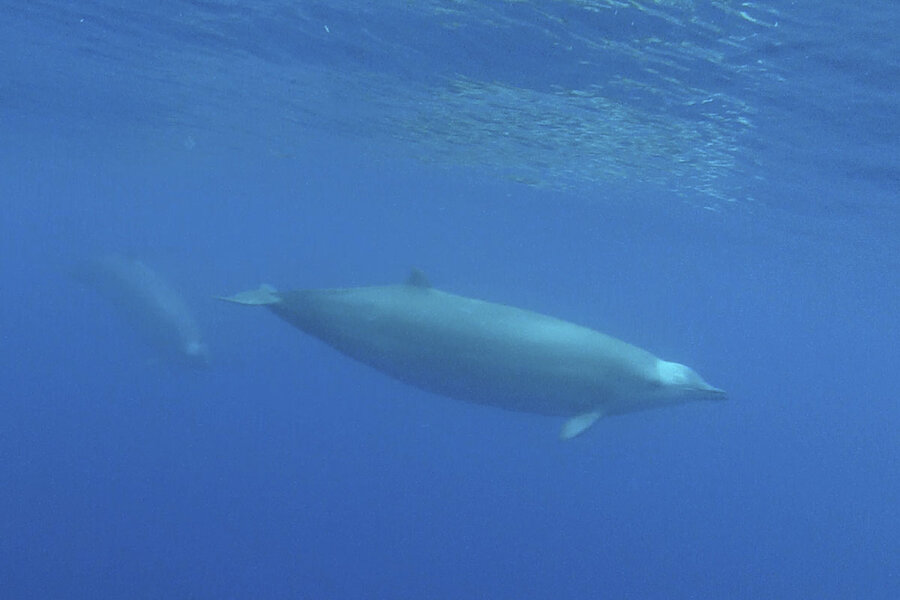First-time video captures rare True's beaked whale up from the depths
Loading...
For the first time, the elusive True's beaked whale – one of the most mysterious aquatic mammals on Earth – has been captured on video.
True's beaked whales are known for extremely deep dives, spending 92 percent of their lives underwater, and can spend hours beneath using only a single breath of air. They are not attracted by boats, travel only in small groups, and do not leap out of the water playfully like dolphins. Many of the researchers who study these creatures may go their entire lives without ever seeing one.
“Imagine,” said Natacha Aguilar de Soto, lead author of the study that includes the rare footage of the whale, according to The Washington Post. “These are animals the size of elephants that we just can't find. They're a mystery.”
But in 2013, a colleague sent her a video clip of three of the whales, including a never-before-photographed calf, taken by students in Archipelago of the Azores in Portugal. Dr. Aguilar de Soto, a marine biologist with the University of St. Andrews in Scotland and the University of La Laguna in the Canary Islands, knew what she was seeing almost instantly, but the sight of the whales is so rare, she had trouble processing it at first.
“When I saw the video, I just couldn’t believe it,” she said. “I thought, 'My God, these are True's beaked whales.' ”
It's easy to understand the initial disbelief when you consider the rarity of the creature. Usually, beaked whales are seen only when they occasionally wash up dead on shore, or pulled up to the surface when they become entangled in fishing nets. As The Christian Science Monitor reported during one beaching in July 2015:
Swimmers and sunbathers on Jones Beach in Plymouth, Mass. were joined ... by an unexpected guest: a rarely seen beaked whale.
The 17-foot-long female whale weighing almost a ton had died by the time it washed up on the beach. The New England Aquarium said it believes the animal was a Sowerby’s beaked whale, a species of deep-water whale that inhabits northern waters and virtually never approaches the shore.
The aquarium said in a statement ... that beaked whales are “so rarely seen that New England Aquarium biologists have been conferring to determine the exact species,” according to the Boston Globe. The aquarium has not seen a beaked whale in close to a decade, the statement said. Usually, sightings of Sowerby’s beaked whales are limited to fishermen who find the whales caught in their nets.
“It’s a glimpse into a habitat that’s not so far away, but it’s still a world away,” aquarium spokesman Tony LaCasse told the Boston Herald of the sighting. “They live in a world of their own.”
The True's beaked whale is one of about 22 species of beaked whales, three of which were discovered in the past 20 years alone. This rare group of toothed whales in the family Ziphiidae is very poorly understood by scientists, who generally rely on photographs, video, tagging, and live specimens to understand the habits of the creatures that they study. Their true range, extent, and function in the ocean's ecosystem is still a matter of debate. And now, the short 46-second video clip sent to Aguilar de Soto is all the video that we have of the elusive True's beaked whale.
The video, along with photographs of other sightings and DNA analysis from washed-up True's beaked whales appeared alongside an extensive study in PeerJ that included an identification of a specimen stranded in the Canary Islands with a never-before-seen, possibly highly rare, color pattern.
While little is known about beaked whales, researchers do know that they are vulnerable to human factors; many of the creatures have been found with plastic in their stomachs, sometimes even bearing wounds from boat propellers. We also know that they are vulnerable to military sonar, which can confuse whole groups and lead to mass strandings.
But in order to help them as effectively as possible, scientists still need to learn more about these mysterious creatures.
“Beaked whales are an incredible example of the adaptations of mammals to the ocean,” Aguilar de Soto said. “They overcome incredible physiological challenges to dive, but that means they are very sensitive to anything that changes or challenges the physiological balance.”








